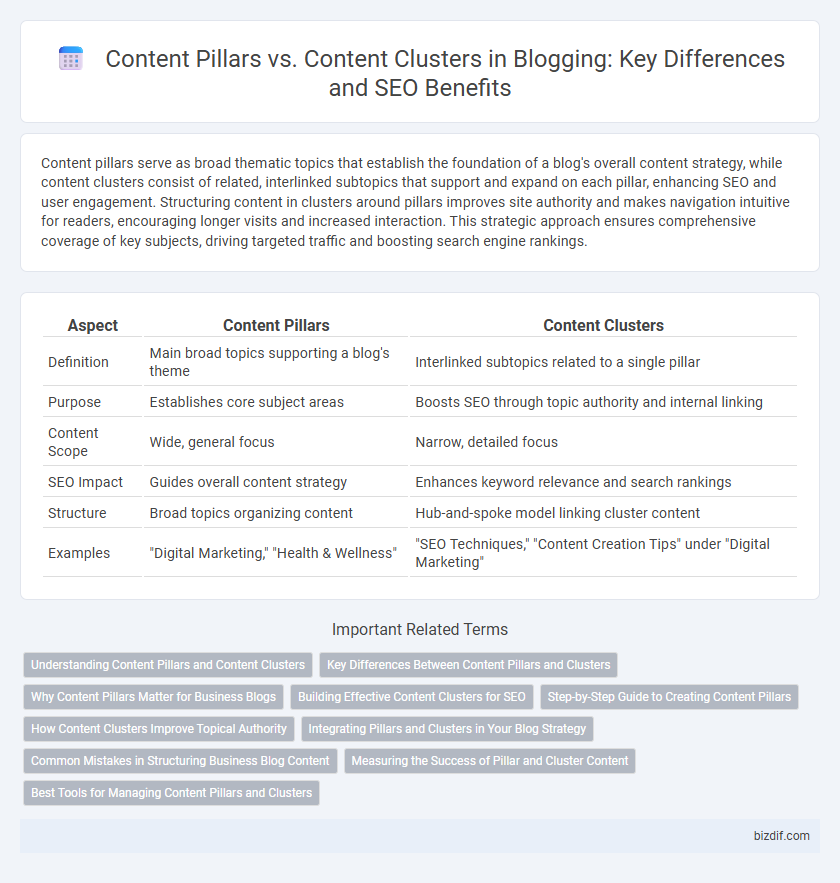Content pillars serve as broad thematic topics that establish the foundation of a blog's overall content strategy, while content clusters consist of related, interlinked subtopics that support and expand on each pillar, enhancing SEO and user engagement. Structuring content in clusters around pillars improves site authority and makes navigation intuitive for readers, encouraging longer visits and increased interaction. This strategic approach ensures comprehensive coverage of key subjects, driving targeted traffic and boosting search engine rankings.
Table of Comparison
| Aspect | Content Pillars | Content Clusters |
|---|---|---|
| Definition | Main broad topics supporting a blog's theme | Interlinked subtopics related to a single pillar |
| Purpose | Establishes core subject areas | Boosts SEO through topic authority and internal linking |
| Content Scope | Wide, general focus | Narrow, detailed focus |
| SEO Impact | Guides overall content strategy | Enhances keyword relevance and search rankings |
| Structure | Broad topics organizing content | Hub-and-spoke model linking cluster content |
| Examples | "Digital Marketing," "Health & Wellness" | "SEO Techniques," "Content Creation Tips" under "Digital Marketing" |
Understanding Content Pillars and Content Clusters
Content pillars are broad themes that form the foundation of a blog's content strategy, providing comprehensive coverage of key topics relevant to the target audience. Content clusters consist of related subtopics and articles that link back to the main pillar page, enhancing SEO by creating a structured internal linking system. Understanding the relationship between content pillars and clusters helps improve website authority, user experience, and search engine rankings.
Key Differences Between Content Pillars and Clusters
Content pillars are broad, authoritative topics that serve as the foundation of a blog, while content clusters are focused subtopics that link back to these pillars, creating an interconnected web of relevant content. Pillars provide a comprehensive overview and high-level structure, whereas clusters deepen the subject matter with specific, detailed articles targeting niche keywords. This strategy enhances SEO by improving topical authority and boosting organic search rankings through internal linking between clusters and their respective pillars.
Why Content Pillars Matter for Business Blogs
Content pillars provide a structured foundation for business blogs by organizing core topics that address audience needs and establish authority within a niche. They enhance SEO by creating a clear content hierarchy, improving search engine visibility through focused keyword targeting and internal linking. Businesses leveraging content pillars experience increased site traffic, higher engagement rates, and more effective lead generation.
Building Effective Content Clusters for SEO
Building effective content clusters enhances SEO by organizing related blog posts around a central content pillar, improving topical authority and user experience. Each cluster page targets specific long-tail keywords, boosting relevance and ranking for niche searches while supporting the pillar's broader theme. Implementing internal linking between cluster pages and the pillar helps search engines understand site structure and increases keyword visibility.
Step-by-Step Guide to Creating Content Pillars
Creating content pillars begins with identifying core topics that align with your blog's niche and audience interests. Each pillar should be broad enough to support multiple related posts, establishing authority and providing comprehensive coverage of key subjects. Organize content clusters around these pillars by developing detailed, interlinked articles that enhance SEO and user engagement through targeted keywords and thematic consistency.
How Content Clusters Improve Topical Authority
Content clusters enhance topical authority by organizing related blog posts around a central pillar page, creating a comprehensive knowledge base that search engines recognize for relevance and depth. This structured internal linking strategy boosts SEO by signaling subject expertise and improving crawlability. As a result, websites benefit from higher rankings and increased organic traffic within their niche.
Integrating Pillars and Clusters in Your Blog Strategy
Integrating content pillars and content clusters in your blog strategy enhances SEO by organizing topics around central themes and related subtopics, improving search engine relevance and user engagement. Content pillars serve as comprehensive guides on broad subjects, while content clusters provide in-depth coverage of specific keywords connected to the pillar. This approach increases internal linking opportunities, boosts authority on key topics, and drives targeted organic traffic.
Common Mistakes in Structuring Business Blog Content
Common mistakes in structuring business blog content often include confusing content pillars with content clusters, which undermines SEO effectiveness. Content pillars are broad topics that establish authority, while content clusters consist of related subtopics interlinked to support the pillar, driving better search rankings. Failing to clearly differentiate and properly link these elements reduces organic traffic and diminishes user engagement.
Measuring the Success of Pillar and Cluster Content
Measuring the success of content pillars involves tracking key performance indicators such as organic traffic growth, keyword rankings, and user engagement metrics like time on page and bounce rate. For content clusters, success is evaluated by analyzing how well cluster pages support the pillar content through internal linking, improve search visibility across related topics, and drive conversions. Utilizing tools like Google Analytics and SEO platforms enables precise assessment of both pillar and cluster performance, helping to refine content strategy for maximum impact.
Best Tools for Managing Content Pillars and Clusters
Top tools for managing content pillars and clusters include SEMrush, Ahrefs, and HubSpot, which offer powerful keyword research, SEO analytics, and content organization features. Trello and Notion provide flexible project management capabilities, allowing seamless collaboration and structured content mapping. Using these tools enhances strategic content planning, ensures consistent pillar-cluster alignment, and maximizes organic traffic growth.
Content Pillars vs Content Clusters Infographic

 bizdif.com
bizdif.com